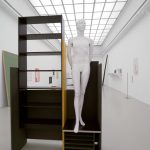The current exhibition at Kunsthalle Bern presents most recent paintings of the German artist Monika Baer in combination with a selection of older works. The show is part of a series of exhibitions that are dedicated to the possibilities of modern painting. Titled “Am Rhein” (On the Rhine), the show is curated by Valérie Knoll (Director, Kunsthalle Bern). The exhibition runs until December 12, 2021.
Monika Baer was born in Freiburg (Germany) in 1964. She studied at Kunstakademie Düsseldorf and currently lives and works in Berlin. She was the winner of Berlin’s Hannah Höch Prize for lifetime achievement in 2020. Recent solo exhibitions include Greene Naftali, New York (2021) and Kunstmuseum Bonn, Germany (2019). Her work has been featured in recent group exhibitions at Museum Brandhorst, Munich (2019); The Museum of Contemporary Art, Los Angeles (2019); among others. Works by her were also represented in the group exhibition “wir blumen” at Kunstverein Hannover 2020.
Monika Baer: Am Rhein / Kunsthalle Bern, Bern (Switzerland). Vernissage, October 15, 2021.
–– Right-click (Mac: ctrl-click) this link to download Quicktime video file.
Exhibition text by curator Valérie Knoll:
If the questions we pose about how to understand painting have greatly changed over the last thirty years, then Monika Baer has been working unstintingly to find how her pictures might respond to these changes. The manner in which she intervenes in this process makes challenging demands upon the viewer.
Since the nineteen nineties, these interventions have resulted in an outstanding body of work, one that has been in constant dialogue with the changing terms and varying consensuses on how the game of painting is played. At the same time, Baer has been careful to maintain her independence, charting a steady course through the vicissitudes around her.
Baer is a mutant, but a mutant with qualities.
One of these is that her paintings rarely stand alone, but rather form part of a wider ensemble. While remaining firmly based on the individual work, they subvert any pretensions to bombastic monumentality. In so doing, Baer explores the possibilities of condensation until the object for her becomes exhausted. This allows her to confront the challenge of maintaining a tension between the individual painting and the group of works. Baer manages this balancing act by deliberately presenting striking images, points of attraction which form a progression from one painting to another.
The motifs that she uses are utterly ordinary – keyholes, bank notes, trees, matchsticks – and the meanings associated with many of them can seem almost hackneyed. But Baer paints these apparently exhausted images in a way that completely revives them. By rendering the objects she paints so specifically, she avoids letting them become signs or symbols, and thereby falling into generalities; instead she pushes painting to the point where the motif literally embodies what it represents. At the same time, the object always retains some remnants of its own, albeit banal, aura, capable of setting off a series of associations in its turn. A tense contradiction emerges between the specific motifs and the sense one gets that ultimately the painting is not really about the chain, the brickwork or the breasts. Within this gap, within this dance between literalness, object and abstraction, a dialogue with the viewer opens up.
Is the matchstick by the Rhine also a missile? Although the paintings radiate clarity, there is little in them that is unambiguous. Many of the motifs appear clear and straightforward, while others almost disappear into the texture of the painting. One of the fundamental elements of Baer’s paintings is a movement between antitheses. This is particularly striking when the two visibly converge, and a formal rigor emerges out of the painterly fog. For Baer, painterly elements – whether a fog of paint or the stroke of a brush – are also motifs; they make up the palette and vocabulary that the artist has developed over the entire course of her work. Although the motifs of this vocabulary are taken from everyday life, the latter appears somewhat remote in her paintings, which at any rate offer few points of orientation.
Above all, for all their sometimes almost aggressive radiance, nothing is transfigured in these works. I am writing these lines while sitting in front of one of them, and when I glance back from the screen to it, I think I can make out a delirious haiku. And then I ask myself, is this perhaps the work of a poetic conceptual artist, who has become ever more skilled in hiding her true face behind a series of masks?
The answer is no. But the impression that she is playing the role of someone else is a marvelous coup in the development of her painting.
Monika Baer’s exhibition Am Rhein is another high point in one of the most important of the Kunsthalle Bern’s recent exhibition series, which has been dedicated to the possibilities of contemporary painting. Am Rhein brings together Baer’s most recent paintings from a new group of works and combines them in new constellations with other of her, which have been carefully chosen but are less well known.




